Shale is a lithified mud — a sedimentary rock composed mostly of clay- and silt-sized grains. There are several ways to define shale. Some definitions are rather narrow. Glossary of Geology published by the American Geological Institute defines shale as a laminated, indurated rock with >67% clay-sized minerals1. This definition clearly discriminates between shale and mudstone. The latter is a similar rock but without notable lamination. It also separates shale from siltstone, which is a mudstone in which the silt predominates over clay.
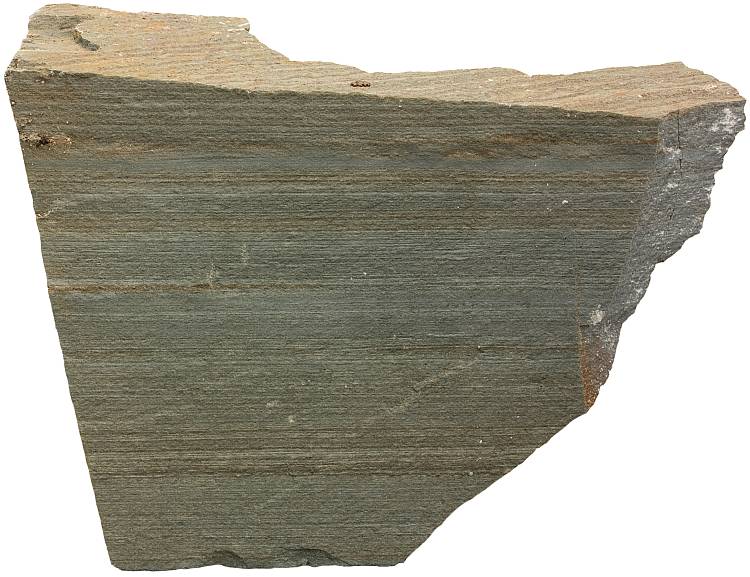
Shale is a fine-grained sedimentary rock that typically shows fine lamination. Finnmark, Norway. Width of sample 9 cm.
Sometimes, however, these rocks are treated as one big family of related and extremely widespread rocks which are collectively referred to as shale, mudrock, or mudstone. These rocks are definitely the most common sedimentary rocks in the crust. It has been estimated that more than half2 of all the sedimentary rocks are various types of mudstones. They are followed by carbonate rocks and sandstones.
Shale is an economically important rock. It may be mined as a fossil fuel (oil shale), but even more importantly, it is a source rock of crude oil and natural gas. Shale is also the rock from which we are extracting hydrocarbons via the use of hydraulic fracturing (fracking).
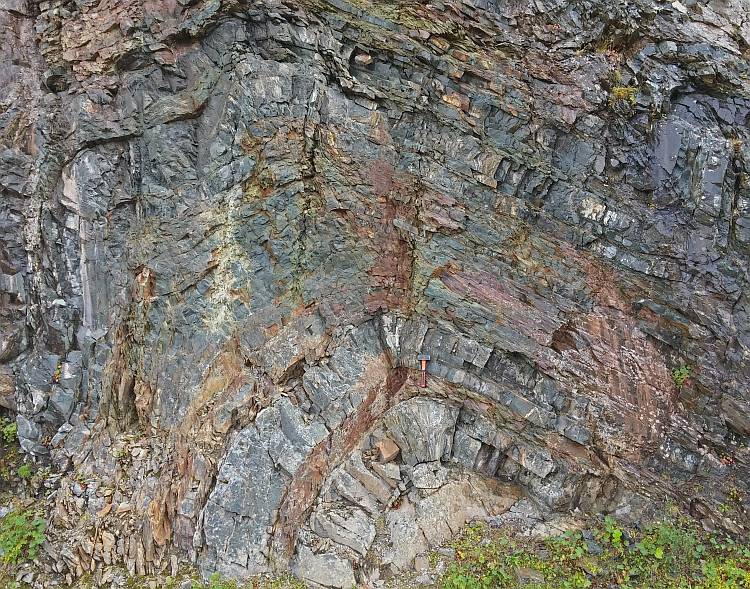
Shale as a typical sedimentary rock is clearly layered and it may be folded by a later orogenic event. Shale outcrop from the northern Norway. Hammer for scale.
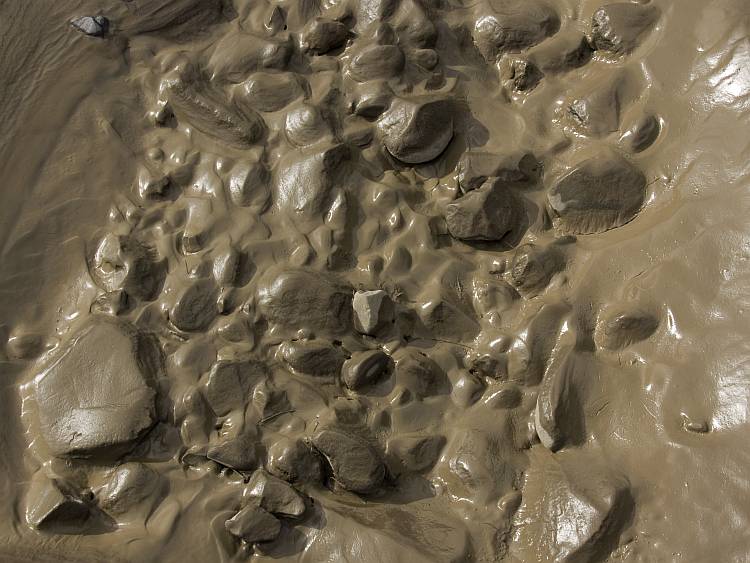
Mud covering a dry riverbed in La Palma, the Canary Islands. The main ingredient of shale is clay which is here on the way from the disintegrated rock higher in the mountains to the sea where it will be finally deposited. Rivers do the hard job of carrying all the mud to the ocean.
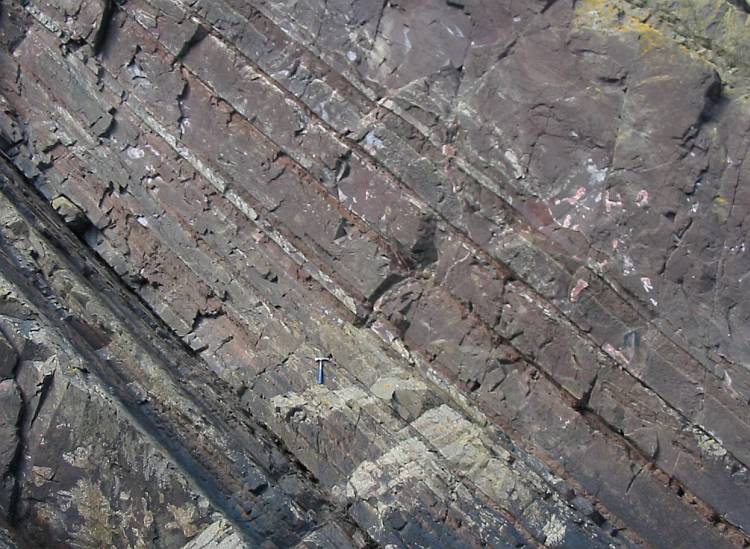
A shale outcrop in Scotland. Hammer for scale.
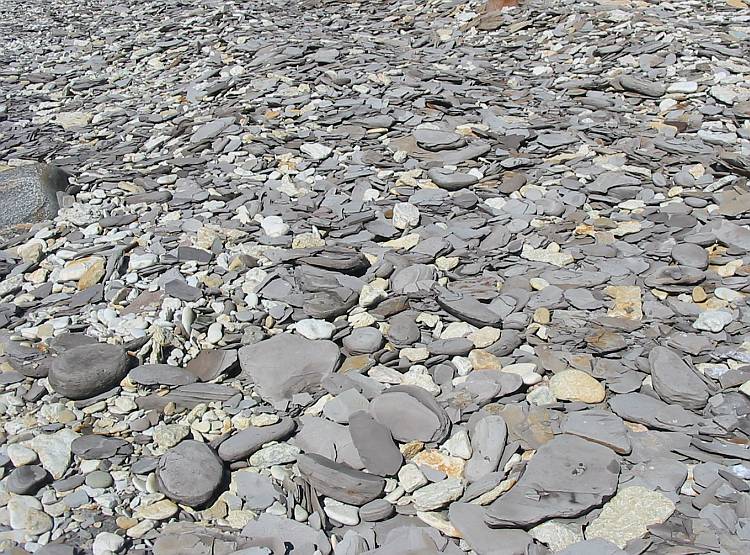
Pebbles of shale on the coast in Estonia. Shale is relatively easy to identify. It tends to produce flat pebbles with a dark-colored dull surface.
Shale and mudstones
A brief overview of rock names used to describe mudstones or rocks derived from them:
| Muddy rock | Description |
| Shale | A laminated and compacted rock. Clay should dominate over silt. |
| Claystone | Like shale but lacks its fine lamination or fissility. Clay should dominate over silt. |
| Clay rock | A synonym of claystone. |
| Argillite | A rather weakly defined rock type. It is a compact and indurated rock buried deeper than most mudrocks and can be considered to be a weakly metamorphosed mudstone. Argillite lacks the slaty cleavage and is not laminated as well as typical shale is. |
| Mudstone | An indurated mud lacking the fine lamination characteristic of shales. Mudstone has roughly equal proportions of clay and silt. “Mudstone” can be treated as a general term that includes all varieties of rocks that are mostly composed of compacted mud. |
| Siltstone | A mudstone in which the silt predominates over clay. |
| Mudrock | A synonym of mudstone. |
| Lutite | A synonym of mudstone although rarely used independently. Usually in combination with some modifier (calcilutite is a very fine-grained limestone). |
| Pelite | Another synonym of mudstone. May be used to describe unconsolidated fine-grained sediments. Is also used to decribe fine-grained carbonates just as lutite. |
| Marl | A calcareous mud. It is a mixture of clay, silt and carbonate grains in various proportions. May be consolidated but in this case it is often named marlstone. |
| Sarl | Similar to marl but contains siliceous biogenic grains instead of carbonate mud. |
| Smarl | A mixture of sarl and smarl. |
| Black shale | Black carbonaceous shale which owes its color to organic matter (>5%). It is rich in sulfide minerals and contains elevated concentrations of several metals (V, U, Ni, Cu). |
| Oil shale | A variety of shale rich in organic matter. It will yield hydrocarbons on distillation. |
| Alum shale | Similar to black shale but pyrite has partly decomposed forming sulfuric acid which reacted with the constituent minerals of the rock to form alum (hydrous potassium-aluminum sulfate). It is rich in several metals just as black shale and has been mined as a source of uranium. |
| Olistostrome | A chaotic mass of mud and larger clasts formed underwater as a gravity-driven mudslide. It lacks bedding. |
| Turbidite | A sediment or a rock deposited by a turbidity current. These deposits form underwater as a mixture of clay, silt and water sliding down the continental slope (in most cases). Turbidite is often composed of alternating silty and clayey layers. |
| Flysch | An old term nowadays largely replaced by turbidite. |
| Diamictite | Purely descriptive term used to describe any sedimentary rock containing larger clasts in a fine-grained matrix. Diamictite may be formed in many ways, but it seems to be a lithified glacial till in the majority of cases. |
| Tillite | A lithified poorly sorted (larger clasts in a muddy matrix) sediment deposited by a glacier. Tillite is a lithified till. |
| Slate | A fine-grained metamorphic rock that can be split into thin sheets (has slaty cleavage). Slate in the vast majority of cases is a metamorphosed shale/mudstone. |
| Metapelite | Any metamorphosed mudstone. Slate, phyllite, and various schists are common metapelites. |
| Phyllite | A metamorphic rock higher in grade than slate and lower than schist. It has a characteristic sheen on the cleavage surfaces given to it by platy mica and/or graphite crystals. |
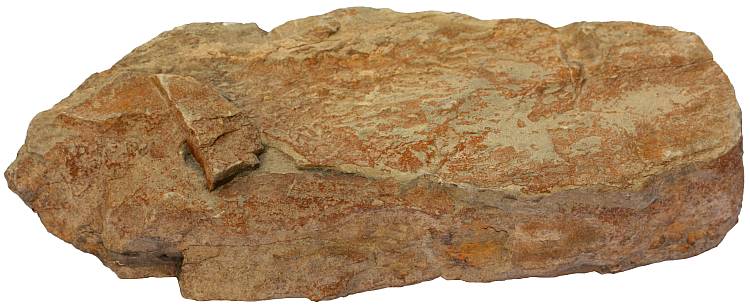
Mudstones rich in coarser silt tend to be lighter in color and do not show fine lamination typical to proper shale. This siltstone from the Spanish Pyrenees is part of a turbidite. Width of sample 12 cm.
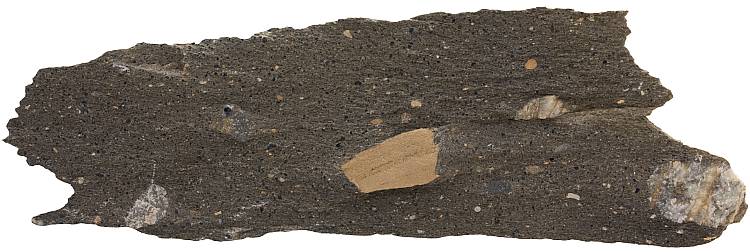
Diamictite is poorly sorted rock with a muddy matric. This diamictite from northern Norway is of glaciogenic origin (tillite) from the Varangian glaciation. Width of sample 12 cm.
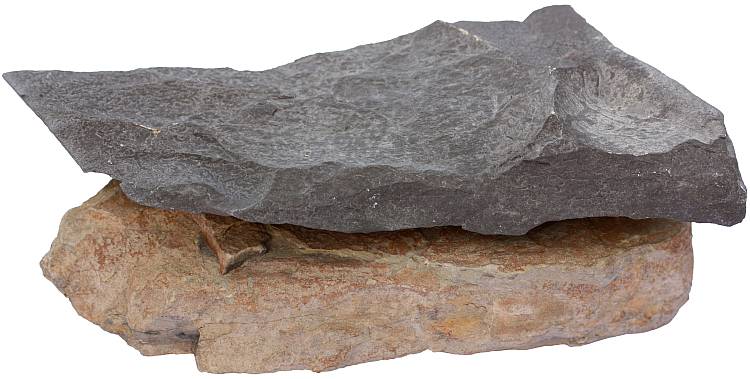
Turbidite is a sedimentary rock unit containing many such siltstone-mudstone pairs deposited on the seafloor during the same episode of gravity-driven subaqueous avalanche of mud. Turbidity sequence is typically composed of many alternating layers of sil and clay. The silt settles before clay which is why there are at least two distinctive layers deposited during the same event. The samples are from a single outcrop in Spain, but they were not next to each other there. The width of the samples is about 20 cm.
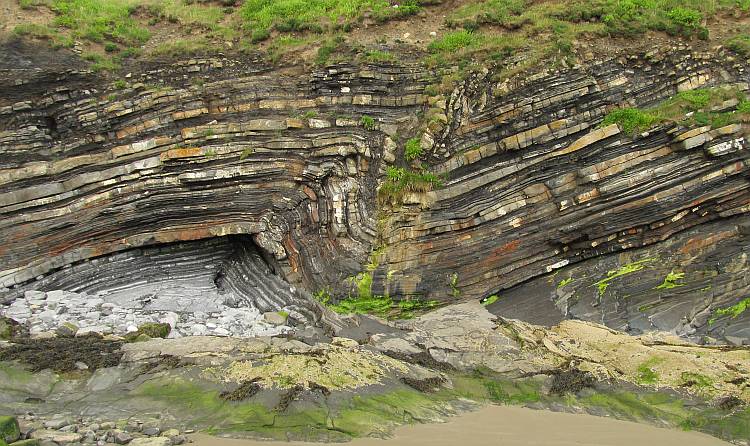
A shale (turbidite) outcrop in Loughshinny, Ireland.
Composition
Shale is so widespread because its main constituents (clay minerals) are very common at the surface. These minerals form as a result of chemical weathering — disintegration of rocks in wet/moist conditions. The minerals that yield clay are various silicates which predominate in the igneous and metamorphic rocks. The most important clay minerals are kaolinite, smectite (montmorillonite) and illite. The first two are common in younger shales. Illite tends to dominate in older (Paleozoic) shales because burial leads to the illitization process which converts smectite to illite.
Mud is a mixture of water, clay and silt (sand). Therefore mudstones also contain various amounts of silt (grain size 2-63 micrometers) and sand in addition to clay minerals. If silt dominates, the rock is usually named siltstone. Silt is mostly composed of mineral quartz, but it may also contain feldspar group minerals and other rock-formers, including heavy minerals.
Important constituents in mudstones may be carbonate or siliceous grains. Both are usually biogenic in origin. Muddy sediments containing lots of these constituents are named marl and sarl, respectively (marlstone, sarlstone if lithified).
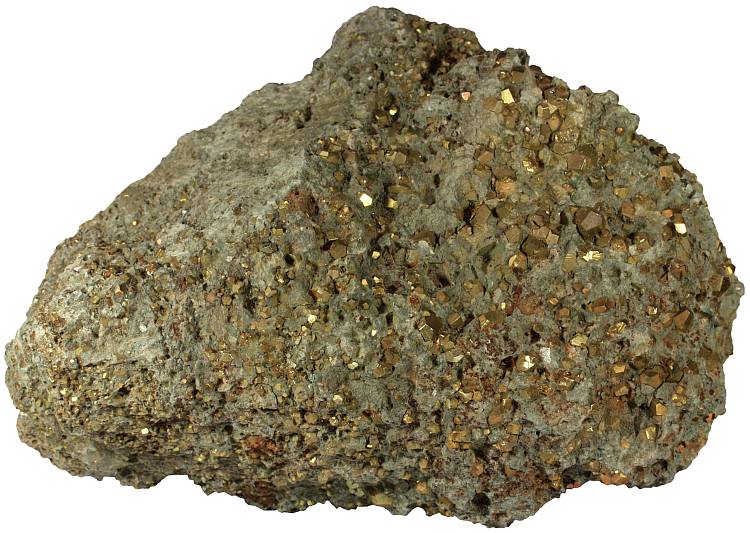
Pyrite is a common mineral in mudstones that formed in reducing conditions. Note the greenish color which also is an indication that free oxygen was not available during the diagenesis. Elba, Italy. Width of sample 22 cm. TUG 1608-6763.
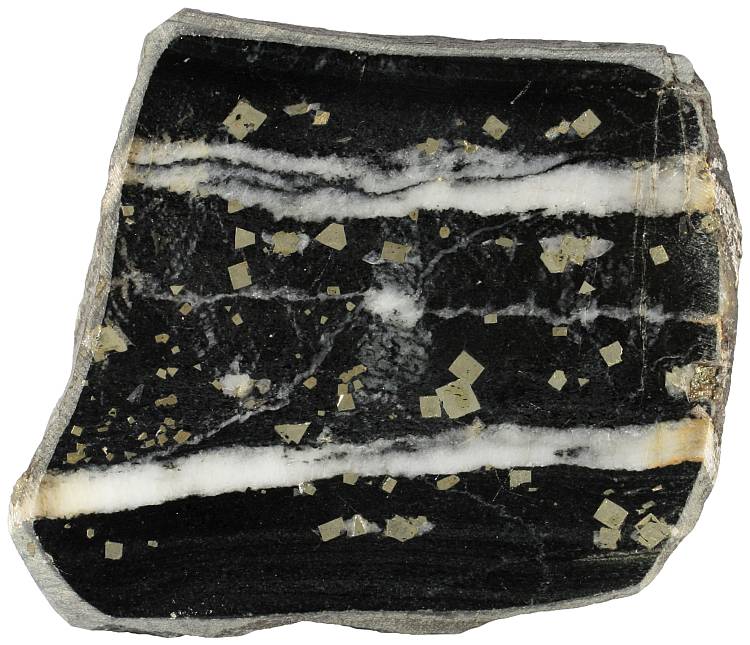
Black shale containing euhedral cubes of pyrite and veins of quartz. Width of sample 8 cm. TUG 1608-2799.
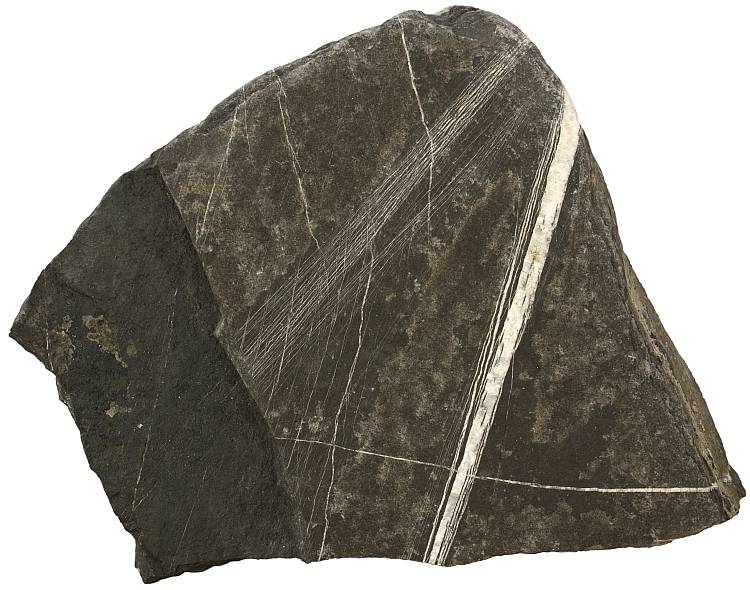
A shale with white calcite veins. These veins are post-depositional (formed in the rock later). Loughshinny, Ireland. Width of sample 10 cm.
Organic matter
A very important component of many shales is carbonaceous material. This is organic matter usually occurring in the rocks as kerogen (a mixture of organic compounds with high molecular weight). Although kerogen does not form more than about 1% of all the shales, the vast majority of kerogen is in mudstones. Shales that are rich in organic matter (>5%) are known as black shales. Black color is given to these rocks by organic matter. Organic matter should be decomposed in normal conditions by bacteria, but high productivity, rapid deposition and burial or lack of oxygen may preserve it. Pyrite is a common sulfide mineral in black shales. Organic matter and pyrite occur together in the same rock because both need oxygen-free conditions for their formation.
Some shales that are especially rich in organic matter are known as oil shales. They yield hydrocarbons on distillation. Oil shale may be used as a fossil fuel, although it is relatively “dirty” fuel because it usually contains lots of unwanted (not burning) minerals. And because of the aforementioned pyrite that causes environmental damage after decomposing to sulfuric acid at the surface.
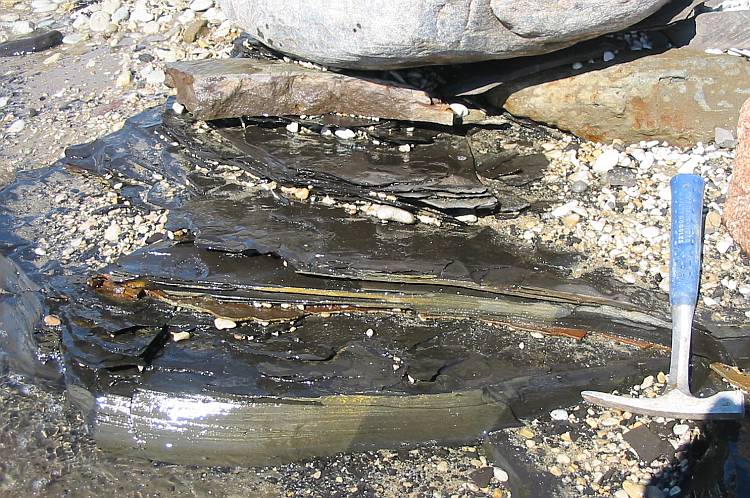
Black shale is a variety of shale containing lots of organic matter that gives it a black color. These rocks are rich in pyrite and several metals like vanadium, uranium, etc. They have been mined in the past as a source of uranium. Black shale in Estonia.
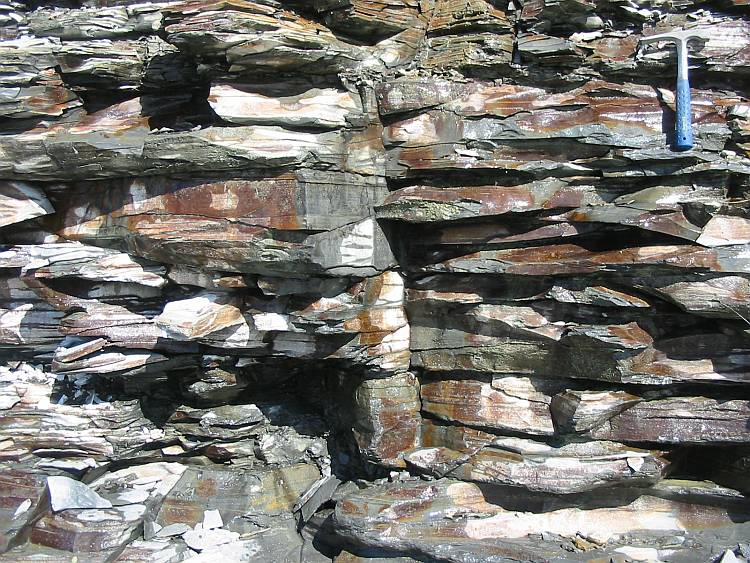
An outcrop of black shale in Estonia.
Formation of shale
Clay minerals that were formed by the disintegration of silicate minerals are usually carried away from their formation place by a running water. They will be settled when fluid turbulence caused by currents and waves is no longer able to counteract the force of gravity. Clay minerals are small enough to be carried in the suspension for a long time. They will be settled after forming larger aggregates either because of flocculation or because of biological activity (filter-feeding organisms that excrete fecal pellets containing mud).
Most clay minerals ultimately make it to the ocean where they are finally deposited on the shelf and continental slope. These water-rich sediments on the gentle continental slope are gravitationally unstable. Some trigger mechanisms like an earthquake, tsunami or simply the weight of the overlying sediments may unleash huge and rapidly moving sediment-laden density currents moving down the slope. These flows are known as turbidity currents and the sediment so formed as turbidite. Turbidite is often composed of alternating silt- and clay-rich layers which form because silt tends to settle more rapidly and before the clay, while clay-rich layers form after that and are thicker in more distal parts of the turbidite sequence. Many such layers may follow each other, forming a thick marine sedimentary unit.
Deposited mudstone contains disoriented clay aggregates which creates lots of pore space that is filled with water. As more sediments accumulate, the weight of the overlying sediments causes compaction — clay aggregates take preferred orientation perpendicular to the stress direction, pore space is reduced, and water is pressed out of the rocks. As the temperature and pressure increase, changes in mineralogy will commence. This is not metamorphism, though. These changes take place at relatively shallow depths and moderate temperatures and the process is called diagenesis. There is, of course, no sharp boundary between diagenesis and metamorphism. In many cases it may be next to impossible to tell for sure whether the particulate rock is still sedimentary or already metamorphic. Pelitic rocks in hand sample are usually considered to be metamorphic when they demonstrate clear slaty cleavage and have a more reflective surface due to larger mica flakes grown at the expense of former clay minerals.
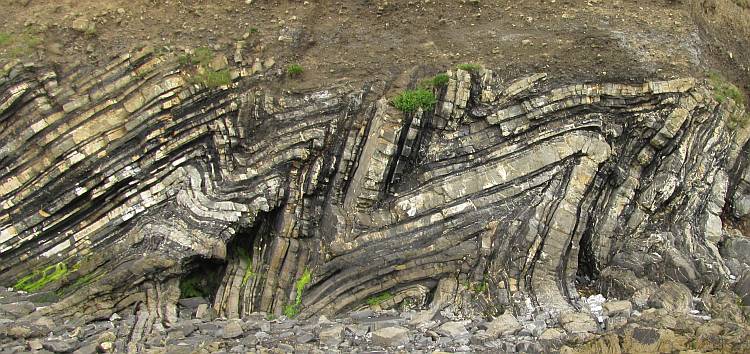
Heavily folded turbidite at Loughshinny, Ireland.
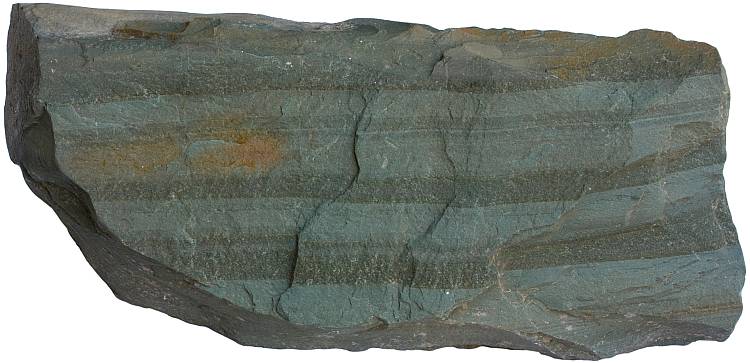
Green color indicates reducing conditions of formation. Finnmark, Norway. Width of sample 19 cm.
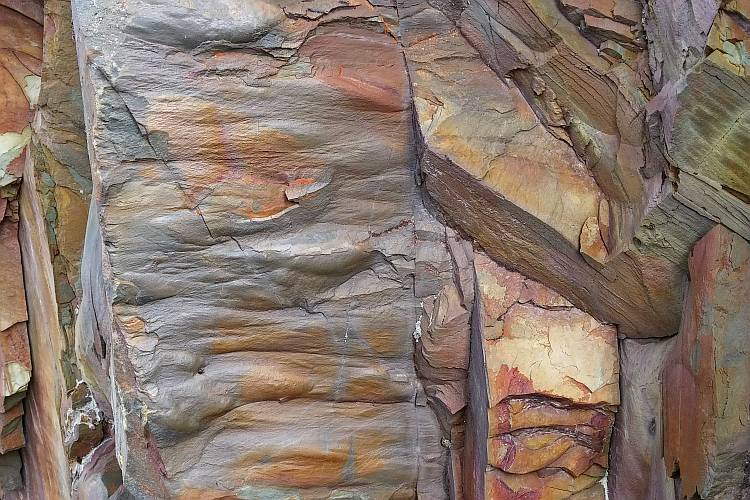
Sole markings are common features (casts) on the lower surfaces of shale layers. They can be used to show the way up and paleocurrent directions.
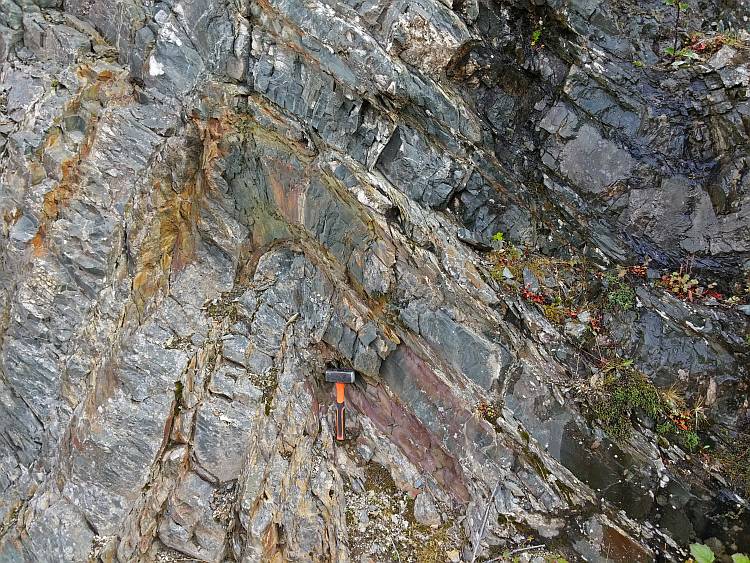
Folded shale outcrop. Finnmark, Norway.
Diagenesis and hydrocarbons
The process of illitization (smectite is transformed to illite) is a major change that takes place in mudstones during the diagenesis. Illitization consumes potassium (provided usually by detrital K-feldspar) and liberates iron, magnesium and calcium, which can be used by the other forming minerals like chlorite and calcite. The temperature range of illitization is about 50-100°C3. Kaolinite content also decreases with increased burial depth. Kaolinite forms in hot and humid climate. The drier temperate climate tends to favor smectite. The reason is that lots of precipitation washes soluble ions out of the rock, while drier climate does not accomplish this task so effectively. Kaolinite is favored in humid climate because it contains only aluminum in addition to silica and water. Aluminum is highly residual while the constituents of smectite (magnesium and calcium, in addition to aluminum and iron) get carried away more easily.
Another major and economically very important process that takes place during diagenesis (sometimes this stage is referred to as catagenesis) is the maturation of kerogen into hydrocarbons. Kerogen is a waxy substance trapped in the rock, but it will mature into lighter hydrocarbons that are able to move out of the shale and migrate upwards. This process can take place at temperatures between about 50-150°C4 (oil window). This corresponds usually to 2-4 kilometers of burial depth. Lighter hydrocarbons liberated during the processes (known as catalytic and thermal cracking) are now free to migrate upwards. They can form exploitable oil and gas reservoirs if stopped by some sort of structural trap which may be an anticline or a fault boundary. The rock layer that stops the upward movement is in many cases another layer of shale because compacted shale is a tough barrier for liquids and gas. Shale can also form an aquiclude between water-bearing layers for the same reason — it does not allow water to flow easily through the rock (has low permeability).
This is also the reason why some of the formed hydrocarbons are not able to migrate out of the source rocks. This resource is still at least partly available to us if we drill holes and inject pressurized water into the rock which will cause it to fracture. This method is known as hydraulic fracturing (fracking). Cracks formed will be kept open by the sand-grains injected with the water and hydrocarbons trapped in the rocks will become recoverable. Fracturing actually is a common process in the crust. Mineral veins and dikes are cracks in the crust opened and sealed by a highly pressurized fluid or magma.
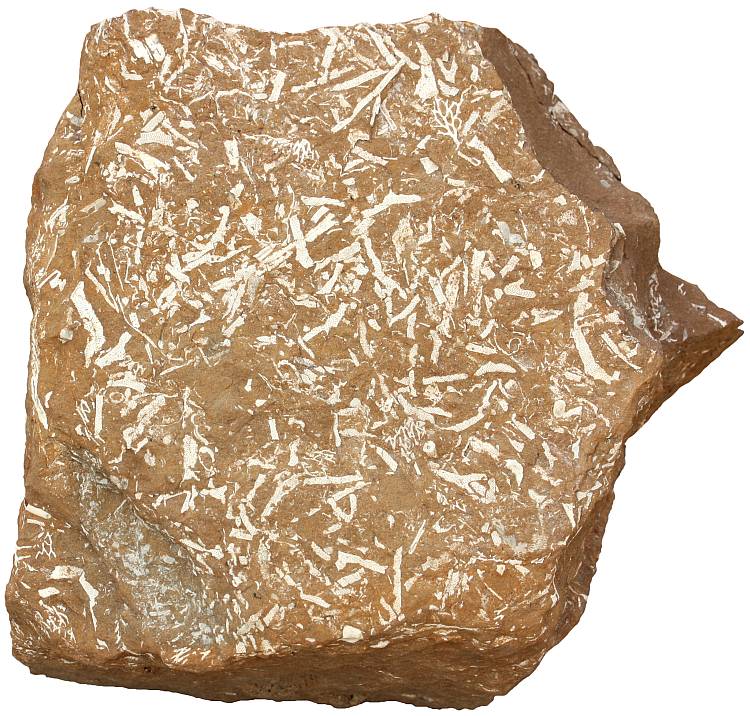
An oil shale (variery kukersite) from Estonia continues to be used as a fossil fuel and raw material for the shale oil industry. The rock is very rich in fossils (bryozoans, trilobites, brachiopods). Kukersite is weakly laminated.
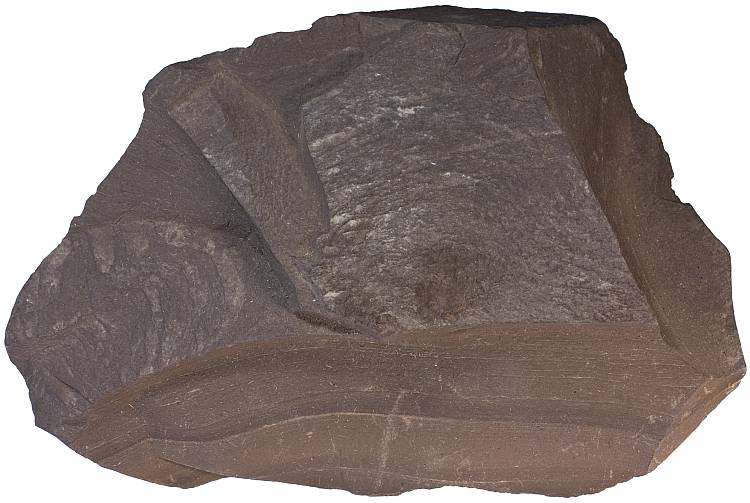
Kerogen-rich shale from Russia. Width of sample 10 cm.
Pictures of related rocks
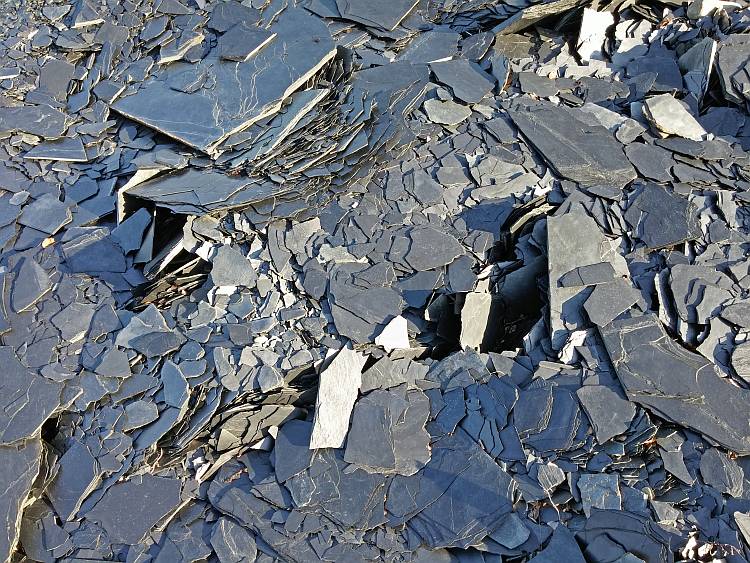
These are slate slabs. Although shale also demonstrates fissility, it does not break into such thin sheets of hard rock and it is clearly duller in appearance.
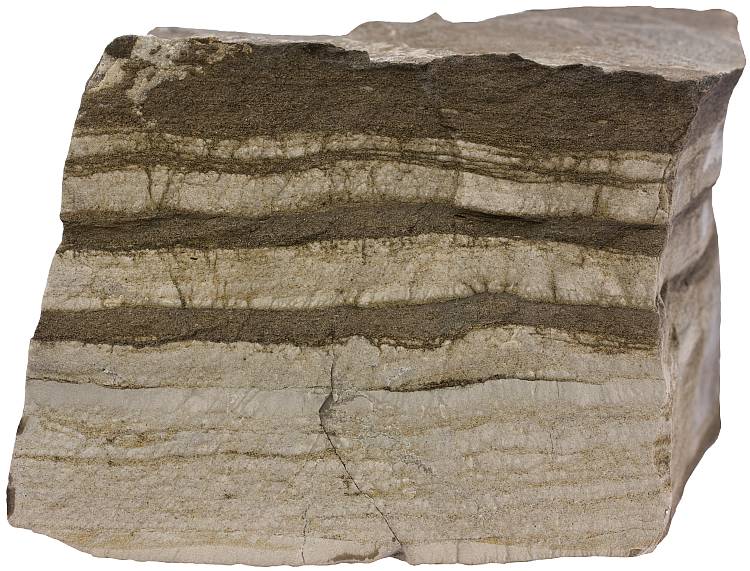
This is a muddy limestone in which light-colored carbonate-rich layers are alternating with siliciclastic (muddy) layers. Biri, Oppland, Norway. Width of sample 9 cm.
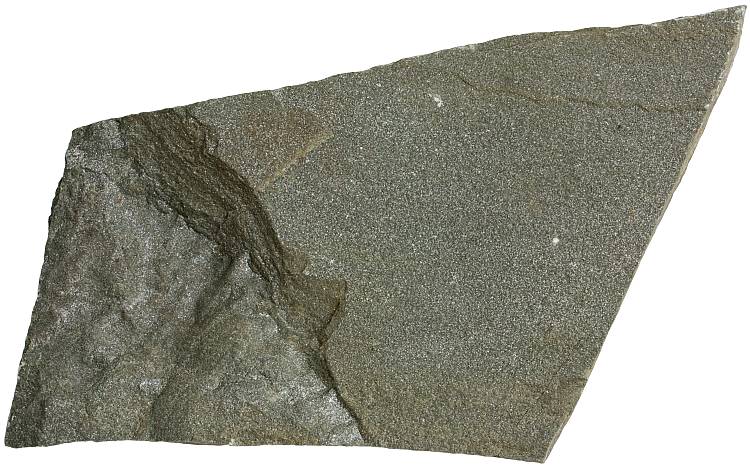
Sandstone also does not need to be pure quartz. It often contains appreciable amounts of clay which may be converted to mica and chlorite during the diagenesis associated with burial. Width of sample 18 cm.

A metamorphosed siliciclastic sedimentary rock now composed of metamorphosed sandstone (quartzite) with a layer of metamorphosed mud (slate).
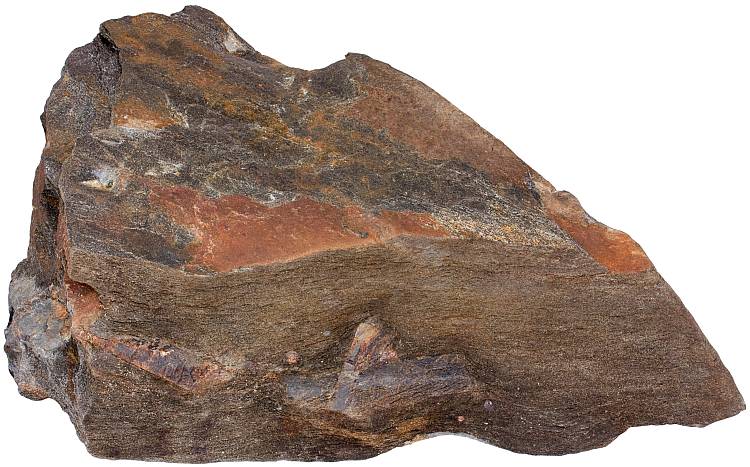
Metapelite is a metamorphic rock which has a mudstone protolith. Staurolite schist is a metapelite. There is a cross-twinned staurolite porphyroblast in the foreground. Tohmajärvi, Finland. Width of sample 19 cm.
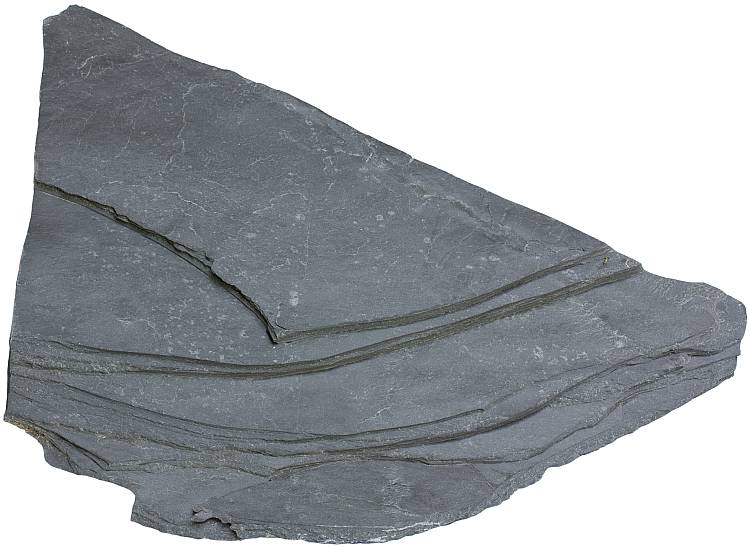
Slate is a metamorphosed shale. It has a slaty cleavage (tendency to break into thin sheets of rocks).
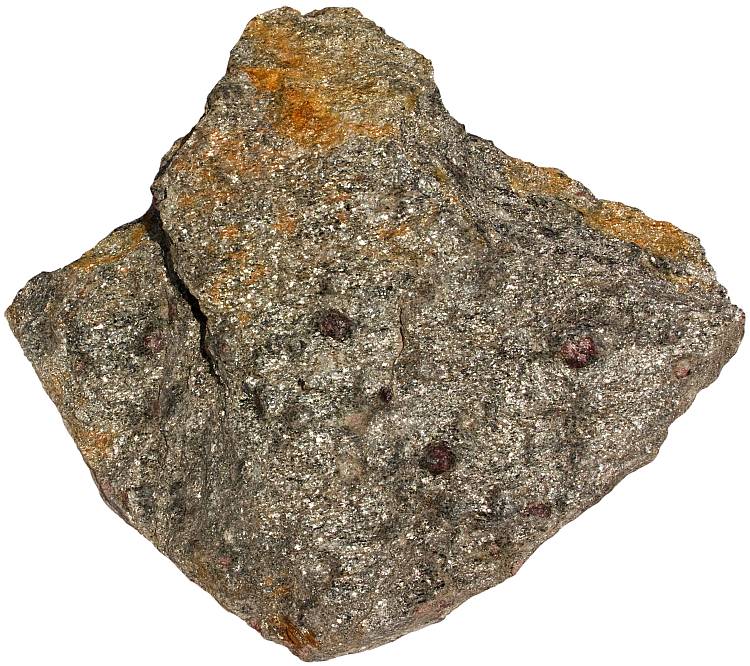
Mica schist is a metapelite — a metamorphosed clay-rich sedimentary rock. Red crystals are almandine garnet porphyroblasts. Narvik, Norway. Width of sample 14 cm.
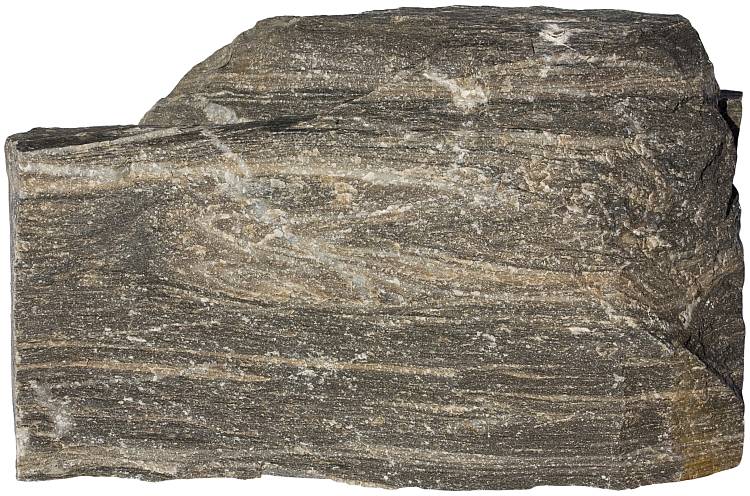
A metamorphosed mudrock clearly containing both clay- and quartz-rich material. Width of sample 14 cm.
References
1. Jackson, J. A. (1997). Glossary of Geology, 4th Edition. American Geological Institute.
2. Davis, Joseph R. (2007). Shale. In: McGraw Hill Encyclopedia of Science & Technology, 10th Edition. McGraw-Hill. Volume 16. 383-386.
3. Nesse, William D. (2011). Introduction to Mineralogy, 2nd Edition. Oxford University Press.
4. Robb, L. (2005). Introduction to Ore-Forming Processes. Blackwell Science Ltd.
Leave a Reply